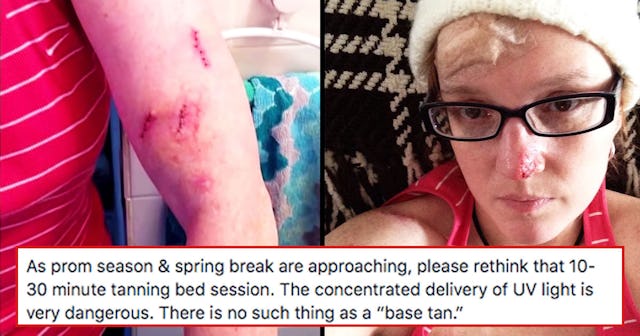After 86 Skin Cancer Surgeries, This Woman Has A Warning We All Need To Hear

Lisa Pace has had dozens of skin cancers removed from her body, and tanning beds are likely to blame
Lisa Pace began using a tanning bed in high school because a friend of hers had one at home. Then, when she left for college, the occasional visit turned into a daily activity. She hated her pale skin and freckles, and she liked the way her darker skin looked.
Today, though, she is all about educating others, so they don’t make the same mistake that she did. At 44 years old, she’s had 86 skin cancer surgeries, all over her body, and she wishes that she hadn’t felt insecure about her pale skin then so she didn’t have to feel insecure about her criss-cross of scars now.
“If I could go back and talk to my 17-year-old self, I would tell (her) that skin cancer is avoidable,” Pace told Today. “(I’d say) don’t get in that tanning bed. Wear sunscreen. Wear protective clothing. People are going to love you for what you look like on the inside, not on the outside.”
Pace said that she was self-conscious of how she looked, especially as an athlete. And that the media didn’t help how she felt about how she looked at all. When she tanned, she felt better, and got better feedback from people around her.
“It was addictive,” she said. “People would say, ‘You look so good, you look tan,’ and it just encouraged me.”
When she got her first job outside of college as a basketball coach, she took advantage of her health insurance coverage and went to the doctor. They found two spots of skin cancer on her leg – but Pace didn’t even know to be concerned. The doctor had to pressure her to schedule a surgery, and even after that, she couldn’t stop herself from going to the tanning bed.
“I blew it off for weeks,” Pace said. “They kept calling me and eventually, they said: ‘You need to get in here now.'”
It was only after she developed deadly cancers on her cheek and nose that she understood what was happening to her: she was battling a disease that was trying to take her life, and it was leaving wounds. A few surgeries turned into a few more, and they didn’t stop. Pace was going to the doctor constantly, and having surgeries every few months to stop the spread of cancer.
More people are diagnosed with skin cancer each year than with all other cancers combined. The most dangerous form of skin cancer, melanoma, will affect almost 100,000 people this year, and 7,000 will die of the disease. At the same time, rates of diagnosis are soaring as a generation of people who were told tanning is attractive pay the price for decades spent sunning and tanning.
Skin cancer can appear at any age, but begins to spike starting at about age 15 in women.
While indoor tanning use has dropped significantly in recent years, it is still popular among tens of millions of Americans, primarily women. Yet even using indoor tanning beds even once before age 35 can increase your risk of melanoma by 59 percent, and using them regularly ups the risks even more. Tanning beds deliver 15 times the ultraviolet light that the sun does at midday – and UV light is considered a carcinogen.
The best way to avoid too much sunlight is with UV-protected hats, clothing, and sunglasses, as well as through the daily application of sunscreen during warmer months.
The best way to spot skin cancer is through the ABCDE method of looking at spots on your skin. Look for (A)symmetry, irregular or ragged (B)orders, unusual or different shades of (C)olor, a (D)iameter that is larger than a pencil eraser, and (E)volving shape, size, and color. In general, point out anything to a doctor that looks concerning, and remember that you can have someone help you look on your back or other hard-to-access spots. Skin cancer is most common on places that are exposed to the sun (or tanning beds).